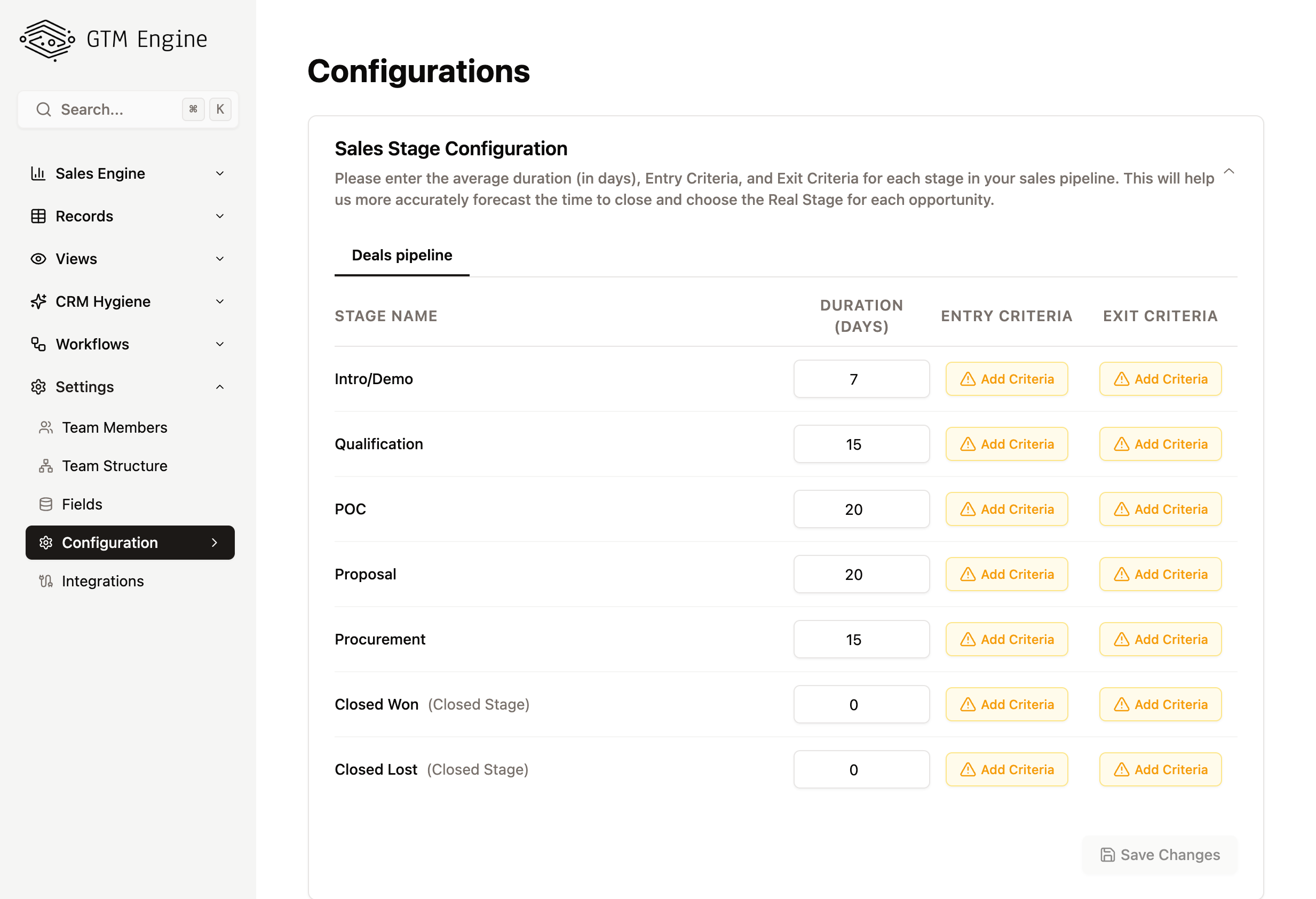
Feature Overview
Sales Stage Configuration is a setup feature that allows you to define the parameters of your sales funnel stages within GTM Engine. While the system automatically imports your basic sales stages from your CRM, you'll need to manually configure additional critical information such as stage duration, entry criteria, and exit criteria to maximize the system's forecasting capabilities.
Benefits to the User
- More accurate forecasting: Properly configured sales stages enable GTM Engine to provide precise time-to-close predictions
- Automated stage identification: The system can automatically determine the correct sales stage for each opportunity based on actual interaction data
- Improved pipeline visibility: Get a clearer understanding of deal progression through your sales funnel
- Enhanced risk identification: Identify opportunities that are lingering too long in specific stages
- Data-driven coaching opportunities: Use stage progression metrics to coach sales team members
Accessing the Feature
- Log in to your GTM Engine account
- Navigate to the main menu and select Settings to open the Settings menu
- In the Settings menu, click on Configuration and Sales Stage Configuration in the page
Step-by-Step Usage Guide
Initial Setup
- When you first access Sales Stage Configuration, you'll see your sales funnel stages that have been automatically imported from your CRM for both your Deals Pipeline and your Renewals Pipeline
- Note that while stage names are imported, you'll need to manually configure:
- Stage duration expectations
- Entry criteria for each stage
- Exit criteria for each stage
Configuring Stage Duration
- Click on the tabs at the top to select the Pipeline you wish to edit, whether the Deals Pipeline or the Renewals Pipeline
- For each sales stage, locate the Duration field
- Enter the typical or expected number of days an opportunity should remain in this stage
- Click Save after entering each duration
Defining Entry Criteria
- For each sales stage, locate the Entry Criteria section
- Enter the specific actions, events, or milestones that indicate an opportunity has entered this stage
- Be as specific as possible (e.g., "Prospect has agreed to a product demo")
- Click Save after defining entry criteria for each stage
Defining Exit Criteria
- For each sales stage, locate the Exit Criteria section
- Enter the specific actions, events, or milestones that indicate an opportunity is ready to move to the next stage
- Be as specific as possible (e.g., "Prospect has received and reviewed the proposal")
- Click Save after defining exit criteria for each stage
Tips and Best Practices
- Be realistic with stage durations: Review your historical sales data to determine accurate average durations for each stage
- Use observable criteria: Define entry and exit criteria based on concrete actions that can be tracked through emails, meetings, and calendar invites
- Review and refine: Periodically review your stage configuration settings as your sales process evolves
- Align with your team: Ensure your sales team understands and agrees with the defined criteria to maintain data consistency
- Consider different deal sizes: You may want to set different duration expectations for small, medium, and enterprise deals
Important Note: Completing the Sales Stage Configuration is a critical setup step. Without proper configuration, GTM Engine's forecasting accuracy and automatic stage identification capabilities will be limited. Take the time to configure these settings thoroughly during initial setup.

